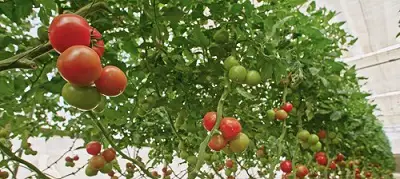If you’re looking for a way to grow tomatoes without soil, hydroponic gardening is a great option. Hydroponic systems allow you to grow plants in nutrient-rich water, which can lead to faster growth and larger yields. However, like any type of gardening, hydroponic tomato growing can have its challenges. In this article, we’ll cover some of the most common problems that hydroponic tomato growers face and provide solutions to help you grow healthy and robust plants.
Common Problems with Hydroponic Tomatoes
Here are some of the most common problems that hydroponic tomato growers face:
1. Nutrient Deficiencies
Since hydroponic systems rely on nutrient-rich water instead of soil, it’s crucial to maintain the proper nutrient balance. Nutrient deficiencies can lead to stunted growth, yellowing leaves, and poor fruit development.
Solution: Monitor Nutrient Levels and pH
Regularly test your nutrient solution’s pH and nutrient levels to ensure that your plants are getting the right balance of nutrients. Adjust your nutrient solution as needed to correct any imbalances.
2. Temperature Fluctuations
Hydroponic systems can be sensitive to temperature changes. Extreme temperatures can stress plants and lead to reduced growth and poor fruit development.
Solution: Maintain Stable Temperatures
Keep your hydroponic system in a location with stable temperatures. If your system is located in an area that experiences temperature fluctuations, consider using a temperature controller to regulate the temperature.
3. Pests and Diseases
Even though hydroponic systems are less susceptible to soil-borne diseases, they can still be affected by pests and other diseases. Common pests that can affect hydroponic tomatoes include spider mites, whiteflies, and aphids.
Solution: Implement Integrated Pest Management (IPM)
Implement an IPM plan that includes monitoring for pests, using physical barriers like sticky traps, and using natural predators like ladybugs or praying mantises to control pest populations. If a disease is detected, remove infected plants and disinfect your system to prevent further spread.
4. Light Levels
Tomatoes require plenty of light to grow and develop properly. Insufficient light can lead to slow growth, weak plants, and poor fruit development.
Solution: Use Adequate Lighting
Ensure that your hydroponic system is receiving enough light for your tomatoes to grow and develop properly. Consider using supplemental lighting if natural light levels are insufficient.
5. Overcrowding
Overcrowding can lead to reduced airflow and increased humidity, which can create a breeding ground for pests and diseases. It can also lead to competition for nutrients, stunted growth, and reduced yields.
Solution: Proper Spacing
Ensure that your plants are properly spaced to allow for adequate airflow and to prevent overcrowding. Consider pruning your plants to promote healthy growth and to prevent overcrowding.
Related Questions
How often should I pollinate my hydroponic tomato plants?
You should pollinate your hydroponic tomato plants every 1-2 days to ensure that the flowers are fertilized and produce fruits.
Can I use natural pollinators like bees in my hydroponic system?
Yes, you can use bees or other pollinating insects to pollinate your hydroponic tomato plants.
Do I need to pollinate every flower on my hydroponic tomato plants?
No, you only need to pollinate the female flowers on your hydroponic tomato plants.
Can poor plant health affect pollination in my hydroponic system?
Yes, poor plant health can affect pollination by reducing the production of pollen or making the flowers less receptive to pollination.
Do I need to hand pollinate if I’m using pollinating insects in my hydroponic system?
It depends on the number of pollinating insects in your system. If you have enough bees or other pollinating insects, they can pollinate your plants effectively without the need for hand pollination.
Conclusion
Hydroponic tomato growing can be a rewarding and efficient way to produce fresh, healthy tomatoes. However, it’s important to be aware of the common problems and solutions to ensure that your plants grow and thrive. Regularly monitor your nutrient levels and pH, maintain stable temperatures, implement

